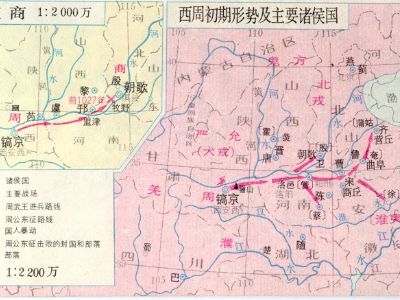(单词翻译:单击)
Zhou Dynasty
周朝
General
概况
In the years around the 10th century BC, after defeating the last Shang ruler, King Wu with a family name of Ji founded the Zhou Dynasty,
大约公元前10世纪,姬氏家族的武王在打败了商朝的最后一个统治者后,建立了周朝。
making Haojing his capital city, near the present city of Xi’an in Shaanxi Province.
他定都镐京,也就是今天的陕西省西安市附近。
As a semi-nomadic tribe, the Zhou learned how to communicate with people of different cultures and gain the allegiance of disaffected city-states.
作为一个半游牧的部落。周朝人学会了如何与来自不同文化的人交流以及如何获得心怀不满的城邦的忠心。
The early Zhou system was proto-feudal, being a more sophisticated form of earlier tribal organization, in which effective control depended more on familial ties than on feudal legal bonds.
周朝早期的制度就是具有封建制度模型的,而这较之早期的部落体系来说更加复杂。早期部落体系中的有效控制更多的依赖于家族的联系而不是封建法治的维系。

Whatever feudal elements there may have been decreased as time went on,the Zhou amalgam of city-states became progressively centralized and established increasingly impersonal political and economic institutions.
随着时间的推移,不管封建元素是否消退,有不同城邦组成的周朝变得日益集权并且建立了一个更加独立的政治与经济制度。
These developments, which probably occurred in the latter Zhou period, were manifested in greater central control over local governments.
这些发展,可能出现在周朝后期,表明了中央对于地方政府的掌控。
The Zhou adopted much of the Shang lifestyle.
周朝采纳了商朝许多的生活方式。
In order to utilize the knowledge of the Shang artisans, they often imported Shang families or communities to the new towns they built.
为了利用商朝工匠的知识,周朝让商朝的家族或团体居住在他们修建的村庄里。
The Zhou also adopted much of the Shang writing system, rituals, and administration techniques.
周朝还采纳了商朝很多的文字系统、仪式和管理技巧。
Agriculture in Zhou Dynasty was more intensive.
周朝的农业更加集中。
All farming lands were owned by nobles, who then gave their land to their serfs,
贵族拥有所有的土地,然后把这些土地给他们的奴隶。
a piece of land was divided into nine squares in the shape of the character jing, with the grain from the middle square taken by the government and that of surrounding squares kept by individual farmers.
一块地会被划分成“井”字型的九块,中间那块的粮食收归政府所有,旁边土地的粮食分给个体农户。
This way, the government was able to store surplus food and distribute them in times of famine or bad harvest.
通过这种方式,政府可以囤积足够的粮食并在饥荒或收成不好时分配粮食。
Some important manufacturing sectors during this period include bronze making, which was integral in making weapons and farming tools.
这个时期重要的生产部门包括青铜制造,而青铜是武器和农具制造中必不可少的一部分。
Again, these industries were dominated by the nobility who direct the production of such materials.
同样,这些产业由贵族掌控,他们管理着这些材料的生产。
Historians divide the Zhou era into Western Zhou from late 10th century BC to late 9th century up until 771 BC and Eastern Zhou from 770 up to 221 BC.
历史学家将周朝分为西周(公元前10世纪至公元前9世纪末,直到公元前771年)和东周(公元前770年至公元前221年)。
The beginning year of Western Zhou has been disputed----1122 BC,1027 BC and other years within the hundred years from late 12th century BC to late 11th century BC have been proposed.
西周开始的年份存在争议。有可能是公元前1121年,公元前1027年或者是公元前12世纪至公元前11世纪100年之间的某一年。
Chinese historians take 841 BC as the first year of consecutive annual dating of the history of China, based on the Records of the Grand Historian by Sima Qian.
中国的史学家依据司马迁《史记》的记载将公元前841年定为连续纪年的元年。
From the beginning of the Eastern Zhou Dynasty to the unification by Qin, China was marked by disunity and continuous conflicts.
从东周的开始到秦朝的统一,中国一直处于割据战乱的状态。


